15.7E: Exercises for Section 15.7
- Last updated
- Jun 2, 2021
- Save as PDF
- Page ID
- 67003
( \newcommand{\kernel}{\mathrm{null}\,}\)
In exercises 1 - 6, without using Stokes’ theorem, calculate directly both the flux of curl⇀F⋅⇀N over the given surface and the circulation integral around its boundary, assuming all are oriented clockwise.
1. ⇀F(x,y,z)=y2ˆi+z2ˆj+x2ˆk; S is the first-octant portion of plane x+y+z=1.
2. ⇀F(x,y,z)=zˆi+xˆj+yˆk; S is hemisphere z=(a2−x2−y2)1/2.
- Answer
- ∬S(curl⇀F⋅⇀N)dS=πa2
3. ⇀F(x,y,z)=y2ˆi+2xˆj+5ˆk; S is hemisphere z=(4−x2−y2)1/2.
4. ⇀F(x,y,z)=zˆi+2xˆj+3yˆk; S is upper hemisphere z=√9−x2−y2.
- Answer
- ∬S(curl⇀F⋅⇀N)dS=18π
5. ⇀F(x,y,z)=(x+2z)ˆi+(y−x)ˆj+(z−y)ˆk; S is a triangular region with vertices (3,0,0),(0,3/2,0), and (0,0,3).
6. ⇀F(x,y,z)=2yˆi+6zˆj+3xˆk; S is a portion of paraboloid z=4−x2−y2 and is above the xy-plane.
- Answer
- ∬S(curl⇀F⋅⇀N)dS=−8π
In exercises 7 - 9, use Stokes’ theorem to evaluate ∬S(curl⇀F⋅⇀N)dS for the vector fields and surface.
7. ⇀F(x,y,z)=xyˆi−zˆj and S is the surface of the cube 0≤x≤1,0≤y≤1,0≤z≤1, except for the face where z=0 and using the outward unit normal vector.
8. ⇀F(x,y,z)=xyˆi+x2ˆj+z2ˆk; and C is the intersection of paraboloid z=x2+y2 and plane z=y, and using the outward normal vector.
- Answer
- ∬S(curl⇀F⋅⇀N)dS=0
9. ⇀F(x,y,z)=4yˆi+zˆj+2yˆk; and C is the intersection of sphere x2+y2+z2=4 with plane z=0, and using the outward normal vector.
10. Use Stokes’ theorem to evaluate ∫C[2xy2zdx+2x2yzdy+(x2y2−2z)dz], where C is the curve given by x=cost,y=sint,0≤t≤2π, traversed in the direction of increasing t.
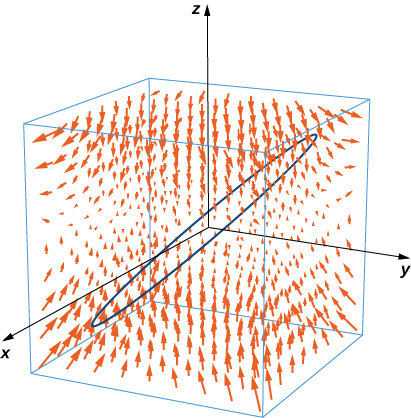
- Answer
- ∫C⇀F⋅dS=0
11. [T] Use a computer algebraic system (CAS) and Stokes’ theorem to approximate line integral ∫C(ydx+zdy+xdz), where C is the intersection of plane x+y=2 and surface x2+y2+z2=2(x+y), traversed counterclockwise viewed from the origin.
12. [T] Use a CAS and Stokes’ theorem to approximate line integral ∫C(3ydx+2zdy−5xdz), where C is the intersection of the xy-plane and hemisphere z=√1−x2−y2, traversed counterclockwise viewed from the top—that is, from the positive z-axis toward the xy-plane.
- Answer
- ∫C⇀F⋅dS=−9.4248
13. [T] Use a CAS and Stokes’ theorem to approximate line integral ∫C[(1+y)zdx+(1+z)xdy+(1+x)ydz], where C is a triangle with vertices (1,0,0),(0,1,0), and (0,0,1) oriented counterclockwise.
14. Use Stokes’ theorem to evaluate ∬Scurl⇀F⋅dS, where ⇀F(x,y,z)=exycoszˆi+x2zˆj+xyˆk, and S is half of sphere x=√1−y2−z2, oriented out toward the positive x-axis.
- Answer
- ∬S⇀F⋅dS=0
15. [T] Use a CAS and Stokes’ theorem to evaluate ∬S(curl⇀F⋅⇀N)dS, where ⇀F(x,y,z)=x2yˆi+xy2ˆj+z3ˆk and C is the curve of the intersection of plane 3x+2y+z=6 and cylinder x2+y2=4, oriented clockwise when viewed from above.
16. [T] Use a CAS and Stokes’ theorem to evaluate ∬Scurl⇀F⋅dS, where ⇀F(x,y,z)=(sin(y+z)−yx2−y33)ˆi+xcos(y+z)ˆj+cos(2y)ˆk and S consists of the top and the four sides but not the bottom of the cube with vertices (±1,±1,±1), oriented outward.
- Answer
- ∬Scurl⇀F⋅dS=2.6667
17. [T] Use a CAS and Stokes’ theorem to evaluate ∬Scurl⇀F⋅dS, where ⇀F(x,y,z)=z2ˆi+3xyˆj+x3y3ˆk and S is the top part of z=5−x2−y2 above plane z=1 and S is oriented upward.
18. Use Stokes’ theorem to evaluate ∬S(curl⇀F⋅⇀N)dS, where ⇀F(x,y,z)=z2ˆi+y2ˆj+xˆk and S is a triangle with vertices (1,0,0),(0,1,0) and (0,0,1) with counterclockwise orientation.
- Answer
- ∬S(curl⇀F⋅⇀N)dS=−16
19. Use Stokes’ theorem to evaluate line integral ∫C(zdx+xdy+ydz), where C is a triangle with vertices (3,0,0),(0,0,2), and (0,6,0) traversed in the given order.
20. Use Stokes’ theorem to evaluate ∫C(12y2dx+zdy+xdz), where C is the curve of intersection of plane x+z=1 and ellipsoid x2+2y2+z2=1, oriented clockwise from the origin.
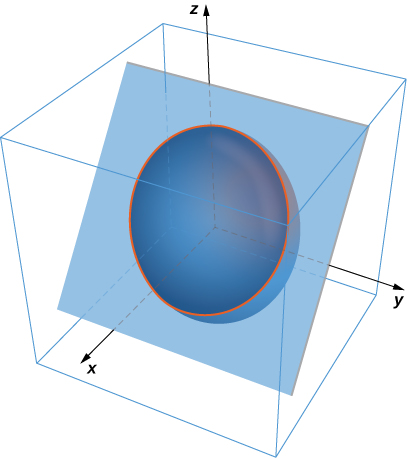
- Answer
- ∫C(12y2dx+zdy+xdz)=−π4
21. Use Stokes’ theorem to evaluate ∬S(curl⇀F⋅⇀N)dS, where ⇀F(x,y,z)=xˆi+y2ˆj+zexyˆk and S is the part of surface z=1−x2−2y2 with z≥0, oriented counterclockwise.
22. Use Stokes’ theorem for vector field ⇀F(x,y,z)=zˆi+3xˆj+2zˆk where S is surface z=1−x2−2y2,z≥0, C is boundary circle x2+y2=1, and S is oriented in the positive z-direction.
- Answer
- ∬S(curl⇀F⋅⇀N)dS=−3π
23. Use Stokes’ theorem for vector field ⇀F(x,y,z)=−32y2ˆi−2xyˆj+yzˆk, where S is that part of the surface of plane x+y+z=1 contained within triangle C with vertices (1,0,0),(0,1,0), and (0,0,1), traversed counterclockwise as viewed from above.
24. A certain closed path C in plane 2x+2y+z=1 is known to project onto unit circle x2+y2=1 in the xy-plane. Let C be a constant and let ⇀R(x,y,z)=xˆi+yˆj+zˆk. Use Stokes’ theorem to evaluate ∫C(cˆk×⇀R)⋅dS.
- Answer
- ∫C(cˆk×⇀R)⋅dS=2πc
25. Use Stokes’ theorem and let C be the boundary of surface z=x2+y2 with 0≤x≤2 and 0≤y≤1 oriented with upward facing normal. Define ⇀F(x,y,z)=(sin(x3)+xz)ˆi+(x−yz)ˆj+cos(z4)ˆk and evaluate ∫C⇀F⋅dS.
26. Let S be hemisphere x2+y2+z2=4 with z≥0, oriented upward. Let ⇀F(x,y,z)=x2eyzˆi+y2exzˆj+z2exyˆk be a vector field. Use Stokes’ theorem to evaluate ∬Scurl⇀F⋅dS.
- Answer
- ∬Scurl⇀F⋅dS=0
27. Let ⇀F(x,y,z)=xyˆi+(ez2+y)ˆj+(x+y)ˆk and let S be the graph of function y=x29+z29−1 with z≤0 oriented so that the normal vector S has a positive y component. Use Stokes’ theorem to compute integral ∬Scurl⇀F⋅dS.
28. Use Stokes’ theorem to evaluate ∮⇀F⋅dS, where ⇀F(x,y,z)=yˆi+zˆj+xˆk and C is a triangle with vertices (0,0,0),(2,0,0) and 0,−2,2) oriented counterclockwise when viewed from above.
- Answer
- ∮⇀F⋅dS=−4
29. Use the surface integral in Stokes’ theorem to calculate the circulation of field ⇀F, ⇀F(x,y,z)=x2y3ˆi+ˆj+zˆk around C, which is the intersection of cylinder x2+y2=4 and hemisphere x2+y2+z2=16,z≥0, oriented counterclockwise when viewed from above.
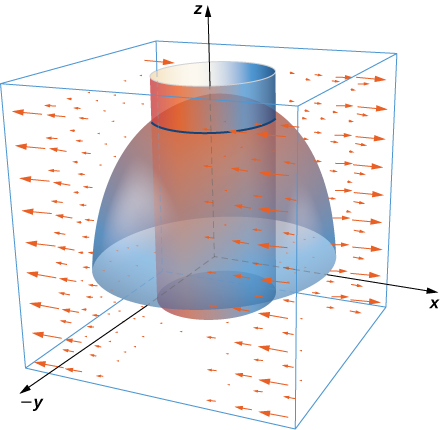
30. Use Stokes’ theorem to compute ∬Scurl⇀F⋅dS. where ⇀F(x,y,z)=ˆi+xy2ˆj+xy2ˆk and S is a part of plane y+z=2 inside cylinder x2+y2=1 and oriented counterclockwise.
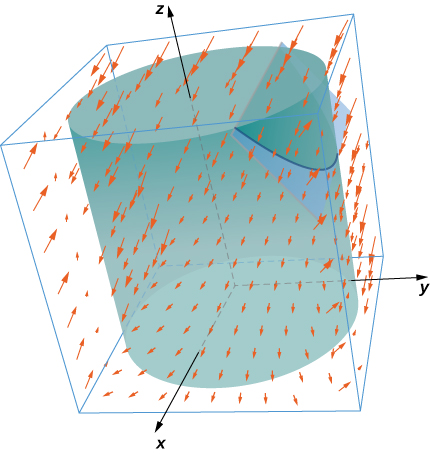
- Answer
- ∬Scurl⇀F⋅dS=0
31. Use Stokes’ theorem to evaluate ∬Scurl⇀F⋅dS, where ⇀F(x,y,z)=−y2ˆi+xˆj+z2ˆk and S is the part of plane x+y+z=1 in the positive octant and oriented counterclockwise x≥0,y≥0,z≥0.
32. Let ⇀F(x,y,z)=xyˆi+2zˆj−2yˆk and let C be the intersection of plane x+z=5 and cylinder x2+y2=9, which is oriented counterclockwise when viewed from the top. Compute the line integral of ⇀F over C using Stokes’ theorem.
- Answer
- ∬Scurl⇀F⋅dS=−36π
33. [T] Use a CAS and let ⇀F(x,y,z)=xy2ˆi+(yz−x)ˆj+eyxzˆk. Use Stokes’ theorem to compute the surface integral of curl ⇀F over surface S with inward orientation consisting of cube [0,1]×[0,1]×[0,1] with the right side missing.
34. Let S be ellipsoid x24+y29+z2=1 oriented counterclockwise and let ⇀F be a vector field with component functions that have continuous partial derivatives.
- Answer
- ∬Scurl⇀F⋅⇀N=0
35. Let S be the part of paraboloid z=9−x2−y2 with z≥0. Verify Stokes’ theorem for vector field ⇀F(x,y,z)=3zˆi+4xˆj+2yˆk.
36. [T] Use a CAS and Stokes’ theorem to evaluate ∮⇀F⋅dS, if ⇀F(x,y,z)=(3z−sinx)ˆi+(x2+ey)ˆj+(y3−cosz)ˆk, where C is the curve given by x=cost,y=sint,z=1;0≤t≤2π.
- Answer
- ∮C⇀F⋅d⇀r=0
37. [T] Use a CAS and Stokes’ theorem to evaluate ⇀F(x,y,z)=2yˆi+ezˆj−arctanxˆk with S as a portion of paraboloid z=4−x2−y2 cut off by the xy-plane oriented counterclockwise.
38. [T] Use a CAS to evaluate ∬Scurl(F)⋅dS, where ⇀F(x,y,z)=2zˆi+3xˆj+5yˆk and S is the surface parametrically by ⇀r(r,θ)=rcosθˆi+rsinθˆj+(4−r2)ˆk(0≤θ≤2π,0≤r≤3).
- Answer
- ∬Scurl(F)⋅dS=84.8230
39. Let S be paraboloid z=a(1−x2−y2), for z≥0, where a>0 is a real number. Let ⇀F(x,y,z)=⟨x−y,y+z,z−x⟩. For what value(s) of a (if any) does ∬S(⇀∇×⇀F)⋅⇀ndS have its maximum value?
For application exercises 40 - 41, the goal is to evaluate A=∬S(⇀∇×⇀F)⋅⇀ndS, where ⇀F=⟨xz,−xz,xy⟩ and S is the upper half of ellipsoid x2+y2+8z2=1, where z≥0.
40. Evaluate a surface integral over a more convenient surface to find the value of A.
- Answer
- A=∬S(⇀∇×⇀F)⋅⇀ndS=0
41. Evaluate A using a line integral.
42. Take paraboloid z=x2+y2, for 0≤z≤4, and slice it with plane y=0. Let S be the surface that remains for y≥0, including the planar surface in the xz-plane. Let C be the semicircle and line segment that bounded the cap of S in plane z=4 with counterclockwise orientation. Let ⇀F=⟨2z+y,2x+z,2y+x⟩. Evaluate ∬S(⇀∇×⇀F)⋅⇀ndS.
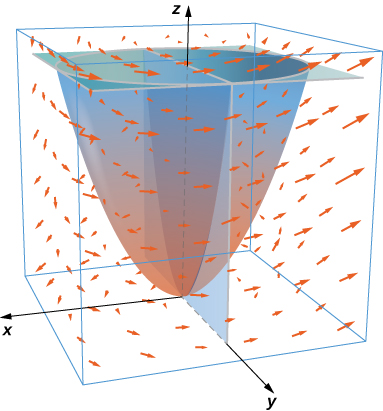
- Answer
- ∬S(⇀∇×⇀F)⋅⇀ndS=2π
For exercises 43 - 45, let S be the disk enclosed by curve C:⇀r(t)=⟨cosφcost,sint,sinφcost⟩, for 0≤t≤2π, where 0≤φ≤π2 is a fixed angle.
43. What is the length of C in terms of φ?
44. What is the circulation of C of vector field ⇀F=⟨−y,−z,x⟩ as a function of φ?
- Answer
- C=π(cosφ−sinφ)
45. For what value of φ is the circulation a maximum?
46. Circle C in plane x+y+z=8 has radius 4 and center (2,3,3). Evaluate ∮C⇀F⋅d⇀r for ⇀F=⟨0,−z,2y⟩, where C has a counterclockwise orientation when viewed from above.
- Answer
- \displaystyle \oint_C \vecs F \cdot d\vecs{r} = 48 \pi
47. Velocity field v = \langle 0, \, 1 -x^2, \, 0 \rangle , for |x| \leq 1 and |z| \leq 1, represents a horizontal flow in the y-direction. Compute the curl of \vecs v in a clockwise rotation.
48. Evaluate integral \displaystyle \iint_S (\vecs \nabla \times \vecs F) \cdot \vecs n \, dS, where \vecs F = - xz\,\mathbf{\hat i} + yz\,\mathbf{\hat j} + xye^z \,\mathbf{\hat k} and S is the cap of paraboloid z = 5 - x^2 - y^2 above plane z = 3, and \vecs n points in the positive z-direction on S.
- Answer
- \displaystyle \iint_S (\vecs \nabla \times \vecs F) \cdot \vecs n = 0
In exercises 49 - 50, use Stokes’ theorem to find the circulation of the following vector fields around any smooth, simple closed curve C.
49. \vecs F = \vecs \nabla (x \, \sin ye^z)
50. \vecs F = \langle y^2z^3, \, z2xyz^3, 3xy^2z^2 \rangle
- Answer
- 0
Contributors
Gilbert Strang (MIT) and Edwin “Jed” Herman (Harvey Mudd) with many contributing authors. This content by OpenStax is licensed with a CC-BY-SA-NC 4.0 license. Download for free at http://cnx.org.


